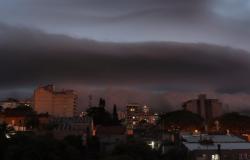Two decades ago, between March 27 and 28, 2004, the south of Santa Catarina witnessed a large and unprecedented meteorological event: Hurricane Catarina. The meteorological phenomenon left a mark on Brazilian history and, 20 years later, it still requires reflections on the impact and lessons learned from this unprecedented event.
Hurricane Catarina was the first and, so far, only hurricane to be officially registered in the South Atlantic. Its formation and trajectory challenged everyone, from experts, Federal and State Government authorities, technicians and, mainly, the population itself.
Significant damage
It was early in the morning from Friday, March 27th, to Saturday, March 28th, 2004, when Hurricane Catarina hit the southern coast of Brazil, causing significant damage to the southern region of Santa Catarina and the northern coast of Rio Grande do Sul.
According to the meteorology team from the Santa Catarina State Secretariat for Protection and Civil Defense (SDC), the hurricane caused winds of up to 180 km/h in the continental region of Balneário Arroio do Silva and heavy rain, leaving a trail of destruction. in your passage.
At the time, 11 people died, 14 municipalities declared a state of public calamity and seven declared an emergency. According to data from the World Bank and the Center for Studies and Research in Engineering and Civil Defense (CEPED UFSC), 250,000 people were affected, 26,443 homeless and homeless, resulting in 211.4 million damages and losses.
Investments after Hurricane Catarina
The impact of Hurricane Catarina was not limited to material damage. The event also highlighted the need for better understanding and preparation for extreme meteorological phenomena in Santa Catarina, as there was no State structure prepared to deal with what happened.
“Both Hurricane Catarina in 2004 and the Morro do Baú disaster in 2008 were, without a doubt, largely responsible for the entire restructuring of the Secretariat from 2011 onwards, as an antenna to receive satellite images, 100% coverage of the Santa Catarina territory with radars, professionals working 24 hours a day, seven days a week”, highlighted Colonel Fabiano de Souza, Secretary of State for Protection and Civil Defense.
Currently, SDC’s Integrated Risk and Disaster Management Center (Cigerd) is equipped and prepared to provide the necessary data in the event of another extreme meteorological phenomenon. “The Secretariat is capable of carrying out all observation of the phenomenon, monitoring, issuing early warnings to the population and making adequate preparation for the response in relation to any damage that could be caused”, he declared.
The name of the hurricane
In Central America and North America, hurricanes are frequent, which is why North Americans follow a sequence and scale with rules for naming storms.
These rules, at the time, were not valid here. Therefore, naming the phenomenon that would hit the south of Santa Catarina in March 2004 was the responsibility of the Epagri/Ciram meteorology team who named Catarina.
The list of possible names was varied. But as the hurricane’s trajectory would follow the coast of Santa Catarina, the team limited the possibilities to two: Anita or Catarina.
Civil Defense before and after
Civil Defense in Santa Catarina was officially established and organized in 1973, under the government of Colombo Machado Salles, through Law No. 4,841. It was only in 2011, however, that Civil Defense gained, through a complementary law, its status as Secretary of State.
“After a major climatic event, with rain and floods in 2008, a technical group was set up, which studied the actions to be carried out in 2009 and 2010. The increase [do status] it was the result of what happened in 2008 and these technical studies”, explains the Secretary of State for Civil Protection and Defense of Santa Catarina, Fabiano de Souza.
Cultural change
According to the secretary, the current Civil Defense is the result of this administrative reform and a reformulation of the State Civil Protection and Defense System, through subsequent legislation. But for him, Hurricane Catarina, in 2004, already demonstrated the need for more technological instrumentation and more qualified technicians to predict phenomena like this.
“Santa Catarina was alerted in 2004 by external agencies. Today we have a much greater capacity, including warning other states of impacts they may suffer, due to the instruments and investments made over the years”, observes the secretary.
The secretary highlights another important aspect in the modernization of state Civil Defense: the change in culture. “Today it is a first-tier government structure, but in addition to responding to climate events, it is much more focused on prevention as a way of protecting people from Santa Catarina. The Civil Defense of Santa Catarina is currently one of the main, if not the main Civil Protection and Defense structure in Brazil’, says Colonel Fabiano de Souza.
—
Collaboration: Grasiele Aguiar / Thuana Raimondi






